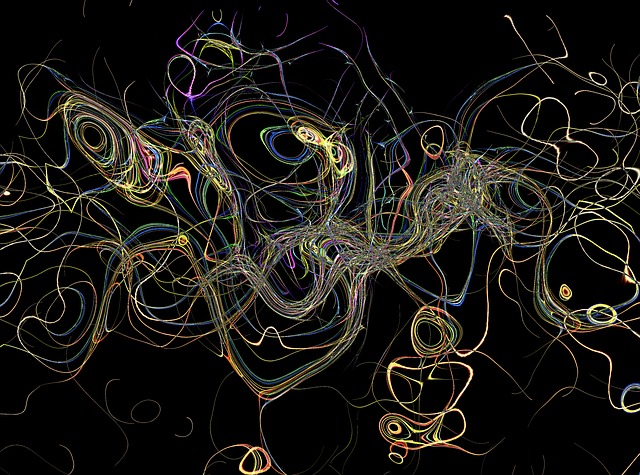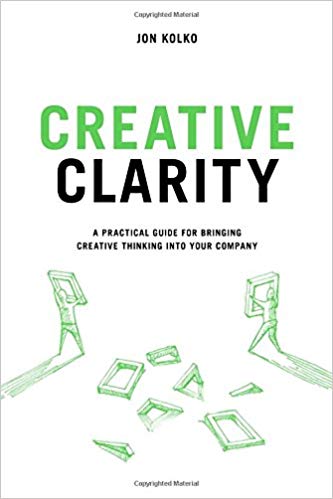Managing ‘wild and unpredictable’ creative chaos in business
I believe creative chaos is the biggest fear business managers have about creativity. Whenever we get to the messy stage of the creative process, managers who are inclined to be linear and analytical want to run for the hills — or at least jump to the solution right away. Unfortunately this is not the best way to generate creative solutions because you haven’t investigated chaos (and ambiguity) with enough depth to discover patterns and insights that lead to clarity — as illustrated in the design/creative thinking process below:
When I discovered Jon Kolko, founder of Austin Center for Design, had written a new book— Creative Clarity: A Practical Guide for Bringing Creative Thinking Into Your Company, I reached out to him to learn more. He is such an eloquent communicator when it comes to explaining the finer points of creativity and design thinking.
Kolko says, “Creativity is the key to addressing ill-formed business threats and for shaping poorly defined market opportunities.” The problem as he sees it, is most companies don’t really know what creativity is, so they can’t benefit from it, and when they try to inject creativity into new methodologies such as design thinking, the result is often chaotic. He writes:
A creative organization is ready to handle the innovation challenges of greenfield markets; to re-imagine the challenges of shrinking market share, and to re-align the misalignment of challenges introduced by running fast and loose. But bringing creativity into your company feels like adding to the mess, not fixing it. Creative processes feel wild and unpredictable–and so do the people doing the creative work. If you hire creative talent, you need well-formed frameworks for managing them and their work.
Design thinking offered us a starting point, as it gave us tools like empathy to help drive innovation. The lean business canvas tells us to run really fast and pivot left and right and left and right. But many of us have started realizing the limitations of design thinking and lean, because after doing a lot of thinking and pivoting, we still have to do a lot of doing. We don’t have the skills to bring the mess into focus.
Creative clarity requires you to do four things:
- Choreograph a creative strategy, describing a clear future even among the blurry business landscape.
- Grow teams that include those creative, unpredictable outcasts; give them the space to produce amazing work; and build a unique form of trust in your company culture.
- Institutionalize an iterative process of critique, conflict, and ideation.
- Embrace chaos but manage creative spin and stagnation.
I asked Kolko how business leaders can develop creative clarity. He shares two skills that can be learned and institutionalized that add clarity to the chaos of creativity.
First, critique aggressively – and acknowledge the role of feelings in criticism. Creativity is personal. I watch my team put everything they have into the things they make, and watch them take personal pride in their creations. And then, we hold a critique, and point out what’s wrong with the things they made. Critique is a special type of meeting, one where a creative team emphasizes areas that an artifact can be improved. It’s productive, in the sense that solutions are built and ideas expand. But it can feel like a pile-on. If I hear that my work is bad, and I put everything I had into it, it’s easy for me to hear that “I am bad.”
During the critique, set expectations, explicitly, that the work is the focus of the conversation. Head off language that seems personal (“You did this…”) and emphasize to the team member that just because they hear something during the critique doesn’t mean they have to do it. Lead by example: dive into the details of the critique yourself, using language you intend to be emulated and focusing on small, nuanced elements of the design rather than broad, sweeping conversation. Emphasizing changes to details helps focus on the work product, rather than the creator.
Then, as a leader, give your team all of the leeway in the world. Remove all the rules, and emphasize that they have control. Rules limit creativity. In a creative exploration, constraints emerge from the work itself and through exploration, not from a top-down and autocratic mandate. Rules say that the rule maker, not the creative person, has the “right answer”; it reinforces that there is, in fact, a right answer.This means abandoning all rules–often the rules that are established by the corporation and are out of your control. Rules about the office (“You can’t put things on the wall” or “You can’t play music”) reinforce that the culture is about rule-following, not exploration.
It seems trivial, but any explicit limitations on behavior trickle in as limitations on the work itself.There are consequences to purposefully breaking the rules. You may be reprimanded. Own the reprimand–it came from you, not the team, and it’s yours to wear. But be prepared: you may be fired. And if that’s the case, it demands consideration of if that workplace is really right for you.
It’s a personal weighing of freedom to be creative against the bounds of a conservative organization.It seems easy to say–just quit your non-creative job if the rules are bearing down upon you. In fact, it’s just as easy to do, because there is a huge, huge demand for people who can execute and drive a creative culture through a company. If your goal actually is to be responsible for creative change, break some glass. But own the consequences.
I appreciate Kolko’s wisdom about creativity and leadership, because it is apparent it has come from years of experience as a design practitioner and educator. I would underscore that as a leader you need to create a psychological container where you can make it safe for everyone involved to explore and experiment.
It’s helpful to see where we are at within the creative process so we don’t get lost in uncertainty. To find clarity out of chaos, look for patterns, and connections between disparate data to formulate innovative ideas. Develop your ability as a leader to observe, question, connect the dots, experiment, reflect, and learn (from mistakes). Model these practices as you guide your team.
For more tips, read what Malcom Gladwell says about embracing creative chaos, The Secret to Finding Creative Solutions from Legendary Designers Milton Glaser and Paula Scher, and check out 12 Ways to Enhance Creativity and Collaboration in Teams
Buy Creative Clarity on Amazon
This book is primarily for people in charge of driving strategic change through an organization. If you are a line manager responsible for exploring a horizon of opportunity, the book will help you establish a culture of creative product development in which your teams can predictably deliver creative results. You’ll learn methods to drive trust among your team members to enable you to critique and improve their work. And as an organizational leader, you’ll complement your traditional business strategies with the new language and understanding you need to implement creativity in a strategic manner across your company.
In a creative environment, chaos is the backdrop for hidden wonderment and success. In this book, you’ll gain clarity in the face of that chaos, so you can build great products, great teams, and a high-performing creative organization.
An earlier version of this post was published in my column at Inc.com 2019
See also:
Why You Need to Cultivate Your Inner Life (as a Leader)
Can Art Inspire Creativity in the Workplace?







